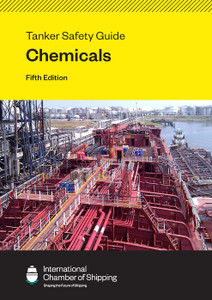
The purpose of this Code is to provide an international standard for the safe carriage, in bulk by sea, of dangerous chemicals and noxious liquid substances listed in Chapter 17 of the Code. The Code prescribes the design and construction standards of ships, regardless of tonnage, involved in such carriage and the equipment they shall carry to minimise the risk to the ship, its crew and the environment.
This edition of the Code incorporates a number of amendments that have entered into force since it was last published in 2016, including:
- Resolutions MEPC.302(72) and MSC.440(99), amending the model form of the International Certificate of Fitness for the Carriage of Dangerous Chemicals in Bulk, which entered into force on 1st January 2020
- resolutions MEPC.318(74) and MSC.460(101), amending Chapters 1, 15, 16, 17, 18, 19 and 21, including a complete revision of the product information set out in Chapters 17 and 18, which entered into force on 1st January 2021.
On 17th June 1983, the Maritime Safety Committee (MSC) adopted, by resolution MSC.4(48), the International Code for the Construction and Equipment of Ships Carrying Dangerous Chemicals in Bulk (IBC Code). Under the provisions of Chapter VII of the International Convention for the Safety of Life at Sea, 1974 (SOLAS 74), as amended, chemical tankers constructed on or after 1st July 1986 must comply with the provisions of the Code.
On 5th December 1985, by resolution MEPC.19(22), the IBC Code was extended by the Marine Environment Protection Committee (MEPC) to cover marine pollution aspects for the implementation of Annex II to the International Convention for the Prevention of Pollution from Ships (MARPOL). Under the provisions of Annex II of MARPOL, chemical tankers constructed on or after 1st July 1986 must comply with the provisions of the Code.
This edition of the Code incorporates a number of amendments that have entered into force since it was last published in 2016, including:
- Resolutions MEPC.302(72) and MSC.440(99), amending the model form of the International Certificate of Fitness for the Carriage of Dangerous Chemicals in Bulk, which entered into force on 1st January 2020
- resolutions MEPC.318(74) and MSC.460(101), amending Chapters 1, 15, 16, 17, 18, 19 and 21, including a complete revision of the product information set out in Chapters 17 and 18, which entered into force on 1st January 2021.
Reference is also made within the Code to the MEPC.2/Circulars, issued annually in December. These contain details of products that have been the subject of Tripartite Agreements and serve, in effect, as a supplement to the IBC Code during the interim period prior to the entry into force of relevant amendments to the Code.
Annex I of the MEPC.2/Circular includes products that are expected to become new entries, or amended information in existing entries in the IBC Code. The product information set out in the circular serves as prior notice of the carriage conditions that will apply to a product when the next set of amendments enters into force.
This publication is appended with a number of other reference documents related to the IBC Code. These provide useful guidance and information with respect to a number of issues addressed by the Code.
Chapter 1 General
1.1 Application
1.2 Hazards
1.3 Definitions
1.4 Equivalents
1.5 Surveys and certification
Chapter 2 Ship survival capability and location of cargo tanks
2.1 General
2.2 Freeboard and stability
2.3 Shipside discharges below the freeboard deck
2.4 Conditions of loading
2.5 Damage assumptions
2.6 Location of cargo tanks
2.7 Flooding assumptions
2.8 Standard of damage
2.9 Survival requirements
Chapter 3 Ship arrangements
3.1 Cargo segregation
3.2 Accommodation, service and machinery spaces and control stations
3.3 Cargo pump rooms
3.4 Access to spaces in the cargo area
3.5 Bilge and ballast arrangements
3.6 Pump and pipeline identification
3.7 Bow or stern loading and unloading arrangements
Chapter 4 Cargo containment
4.1 Definitions
4.2 Tank type requirements for individual products
Chapter 5 Cargo transfer
5.1 Piping scantlings
5.2 Piping fabrication and joining details
5.3 Flange connections
5.4 Test requirements for piping
5.5 Piping arrangements
5.6 Cargo transfer control systems
5.7 Ship?s cargo hoses
Chapter 6 Materials of construction, protective linings and coatings
Chapter 7 Cargo temperature control
7.1 General
7.2 Additional requirements
Chapter 8 Cargo tank venting and gas-freeing arrangements
8.1 Application
8.2 Cargo tank venting
8.3 Types of tank venting systems
8.4 Venting requirements for individual products
8.5 Cargo tank purging
8.6 Cargo tank gas freeing
Chapter 9 Environmental control
9.1 General
9.2 Environmental control requirements for individual products
Chapter 10 Electrical installations
10.1 General
10.2 Bonding
10.3 Electrical requirements for individual products
Chapter 11 Fire protection and fire extinction
11.1 Application
11.2 Cargo pump-rooms
11.3 Cargo area
11.4 Special requirements
Chapter 12 Mechanical ventilation in the cargo area
12.1 Spaces normally entered during cargo-handling operations
12.2 Pump rooms and other enclosed spaces normally entered
12.3 Spaces not normally entered
Chapter 13 Instrumentation
13.1 Gauging
13.2 Vapour detection
Chapter 14 Personnel protection
14.1 Protective equipment
14.2 Safety equipment
14.3 Emergency equipment
Chapter 15 Special requirements
15.1 General
15.2 Ammonium nitrate solution (93% or less)
15.3 Carbon disulphide
15.4 Diethyl ether
15.5 Hydrogen peroxide solutions
15.6 Motor fuel anti-knock compounds (containing lead alkyls)
15.7 Phosphorus, yellow or white
15.8 Propylene oxide or ethylene oxide/propylene oxide mixtures with an ethylene oxide content of not more than 30% by mass
15.9 Sodium chlorate solution (50% or less by mass)
15.10 Sulphur (molten)
15.11 Acids
15.12 Toxic products
15.13 Cargoes protected by additives
15.14 Cargoes with a vapour pressure greater than 0.1013 MPa absolute at 37.8?C
15.15 Hydrogen sulphide (H2S) detection equipment for bulk liquids
15.16 Cargo contamination
15.17 Increased ventilation requirements
15.18 Special cargo pump-room requirements
15.19 Overflow control
15.20 Alkyl (C7?C9) nitrates, all isomers
15.21 Temperature sensors
Chapter 16 Operational requirements
16.1 Maximum allowable quantity of cargo per tank
16.2 Cargo information
16.3 Personnel training
16.4 Opening of and entry into cargo tanks
16.5 Stowage of cargo samples
16.6 Cargoes not to be exposed to excessive heat
Chapter 17 Summary of minimum requirements
Chapter 18 List of products to which the Code does not apply
Chapter 19 Index of products carried in bulk
Chapter 20 Transport of liquid chemical wastes
20.1 Preamble
20.2 Definitions
20.3 Applicability
20.4 Permitted shipments
20.5 Documentation
20.6 Classification of liquid chemical wastes
20.7 Carriage and handling of liquid chemical wastes
Chapter 21 Criteria for assigning carriage requirements for products subject to the IBC Code
21.1 Introduction
21.2 Contents
21.3 Minimum safety and pollution criteria for products subject to Chapter 17 of the IBC Code
21.4 Criteria used to assign the minimum carriage requirements for products that meet the minimum safety or pollution criteria to make them subject to Chapter 17 of the IBC Code
21.5 Column o ? Criteria for special requirements in Chapter 15
21.6 Column o ? Criteria for special requirements in Chapter 16
21.7 Definitions
Appendix Model form of International Certificate of Fitness for the Carriage of Dangerous Chemicals in Bulk
IMO
As a specialised agency of the United Nations, the International Maritime Organization (IMO) is the global standard-setting authority for the safety, security and environmental performance of international shipping. Its main role is to create a regulatory framework for the shipping industry that is fair and effective, universally adopted and universally implemented.
In other words, its role is to create a level playing field so that ship operators cannot address their financial issues by simply cutting corners and compromising on safety, security and environmental performance. This approach also encourages innovation and efficiency.
Shipping is a truly international industry, and it can only operate effectively if the regulations and standards are themselves agreed, adopted and implemented on an international basis. And IMO is the forum at which this process takes place.
- Number of Pages:
- 305
- ISBN:
- 9789280117288
- Published Date:
- September 2020
- Binding Format:
- Paperback
- Book Height:
- 295 mm
- Book Width:
- 210 mm
- Weight:
- 0.9 kg
- Author:
IMO
- Preview:
- Yes
- Publication Date:
- August 2020




